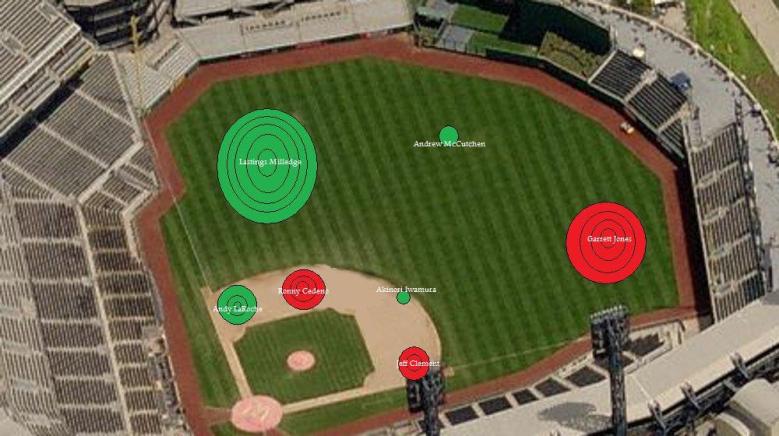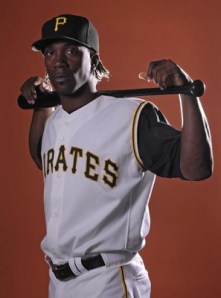About a week ago, I wrote that the next winning Pirates team was beginning to take shape. At the time, I was simply looking at rough individual position player projections (based on a 600 plate appearance season) and noting that two of the three biggest holes could easily be filled by our two top prospects (Pedro Alvarez and Jose Tabata). However, when I looked at those WAR numbers a little closer, I realized that they added up to somewhere around 81 wins. So I decided to take a more detailed look at the current roster to see how many wins we should expect to see in 2010. As I mentioned, my previous WAR numbers were based on 600 plate appearances. Thus, these new projections will generally be less optimistic.
First, a bit about my methodology. I used CHONE’s projections for on-base and slugging percentage. I also based expected plate appearances and innings pitched on CHONE, adjusting them a bit to make everything fit. For defense, I started with each player’s career UZR/150 at his expected position. I adjusted for anyone with a small sample, based on my own expectations. For instance, I bumped Lastings Milledge from his career left field UZR/150 of +10.4 down to +5. I used +5 for Andrew McCutchen, as I expect him to outperform his career mark of -1. And so on. Of course, there is also a positional adjustment included. I estimated base running value, using numbers from Baseball Prospectus as a guide. I tried to keep these numbers pretty close to average for the most part. For pitchers, I put CHONE’s projections into the formula (HR*13+(BB+HBP-IBB)*3-K*2)/IP +3.2 to find a projected FIP. I did not use CHONE’s projected ERA, because we are already accounting for defense in the position player projections. Finally, I plugged all of this info into Sky Kalkman’s WAR spreadsheet.
Here are the position player projections. (Full spreadsheet located here)
|
PA |
OBP |
SLG |
WAR |
| Ryan Doumit |
371 |
0.321 |
0.441 |
1.4 |
| Jeff Clement |
450 |
0.342 |
0.460 |
0.9 |
| Akinori Iwamura |
513 |
0.365 |
0.393 |
2.1 |
| Ronny Cedeno |
373 |
0.303 |
0.389 |
0.3 |
| Andy LaRoche |
498 |
0.343 |
0.408 |
2.0 |
| Lastings Milledge |
455 |
0.345 |
0.423 |
1.2 |
| Andrew McCutchen |
551 |
0.365 |
0.445 |
3.6 |
| Garrett Jones |
540 |
0.324 |
0.476 |
1.1 |
|
|
|
|
|
| John Raynor |
379 |
0.330 |
0.374 |
0.6 |
| Delwyn Young |
340 |
0.320 |
0.402 |
0.4 |
| Pedro Alvarez |
329 |
0.299 |
0.395 |
-0.1 |
| Bobby Crosby |
322 |
0.315 |
0.367 |
0.6 |
| Jason Jaramillo |
275 |
0.324 |
0.372 |
0.8 |
| Brandon Moss |
260 |
0.335 |
0.426 |
0.7 |
| Jose Tabata |
195 |
0.324 |
0.368 |
0.1 |
| Eric Kratz |
49 |
0.294 |
0.399 |
0.1 |
Right off the bat, we see that CHONE has Ryan Doumit producing another disappointing season. His past injury issues are apparent in the low number of plate appearances, and his projected OBP is below average. Nevertheless, with a decent backup in Jason Jaramillo, the Pirates should be able to receive average-ish production from the catching position. Jeff Clement projects as a decent bat, but nothing all that special for a poor defensive first baseman. As I’ve written before, his suspect glove, solid power and limited platoon split make him a good candidate for a bench spot in the future. Akinori Iwamura should produce at about his career level and the shortstop position will be a hole all season. No surprises there, although it wouldn’t surprise me if Ronny Cedeno outplays his projection a bit. I think Andy LaRoche and Lastings Milledge might show a tad more pop than their projections indicate, which would bump each up to slightly above average. CHONE sees Andrew McCutchen’s slugging numbers regressing somewhat, which is perfectly understandable given his lack of power in the minors. McCutchen’s impressive rookie season set some pretty high expectations, and I would be thrilled if he simply matched last season’s production. That being said, the sky’s the limit for him if he continues to drive the ball the way he did in 2009. CHONE expects Garrett Jones’ numbers to drop across the board, which I think is entirely reasonable. Jones also strikes me as a good bench guy down the road, or potentially the left-handed portion of a platoon.
The projections for the remaining position players are not very surprising, outside of Pedro Alvarez. CHONE has Alvarez producing replacement level offense, which seems extremely pessimistic to me. His projection is well below his Minor League Equivalency from Altoona in 2009 (.254/.329/.427), indicating regression as opposed to development. Even with his strikeout issues, I find that hard to believe.
Here are the pitchers. There is nothing too unexpected. The rotation is full of mid-rotation type starters, and Neal Huntington still has some work to do in the bullpen.
|
IP |
FIP |
WAR |
| Paul Maholm |
191 |
4.06 |
2.9 |
| Zach Duke |
173 |
4.37 |
2.0 |
| Ross Ohlendorf |
156 |
4.66 |
1.3 |
| Charilie Morton |
155 |
4.14 |
2.2 |
| Daniel McCutchen |
130 |
4.66 |
1.1 |
| Brad Lincoln |
95 |
4.59 |
0.8 |
| Kevin Hart |
40 |
4.11 |
0.6 |
|
|
|
|
| Kevin Hart |
67 |
4.11 |
0.3 |
| Joel Hanrahan |
63 |
3.90 |
0.6 |
| Steven Jackson |
63 |
4.41 |
0.0 |
| Evan Meek |
57 |
4.18 |
0.4 |
| Jeff Karstens |
50 |
4.89 |
-0.1 |
| Anthony Claggett |
50 |
4.90 |
-0.1 |
| Javier Lopez |
48 |
4.35 |
0.1 |
| Vinnie Chulk |
38 |
4.49 |
0.0 |
| Daniel McCutchen |
32 |
4.66 |
0.0 |
| Tyler Yates |
10 |
4.29 |
0.0 |
| Donald Veal |
10 |
5.37 |
-0.1 |
| Jose Ascanio |
17 |
3.70 |
0.1 |
Add everything up and the Pirates’ expected 2010 win total is 76.3, including a 21% chance of winning at least 81 games. Those numbers could be improved by adding to the bullpen prior to Opening Day. For those convinced that a 100-loss season is on the horizon, there is a 98% chance that the Pirates will win 63 or more games. For the cockeyed optimist, the team has just a 1.3% chance of winning at least 90 games and possibly contending for the postseason.
Here is a graph showing the team’s probability of winning at least X amount of games.

These expectations are extremely preliminary. I will revise the spreadsheet sometime in spring training, when the composition of the team is clearer.






